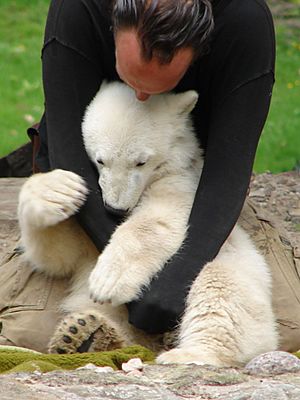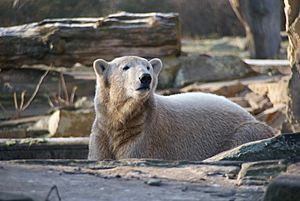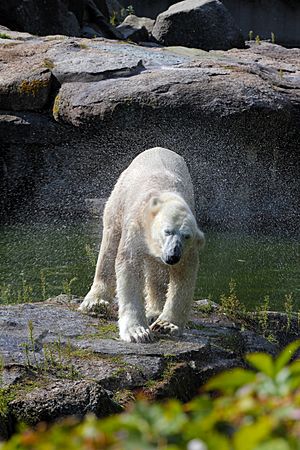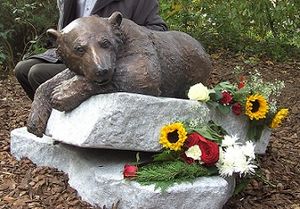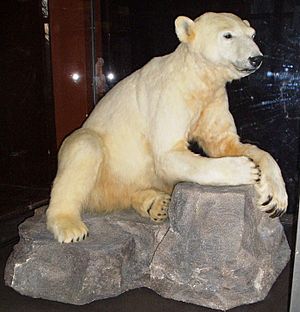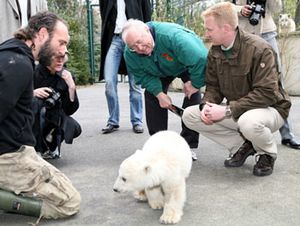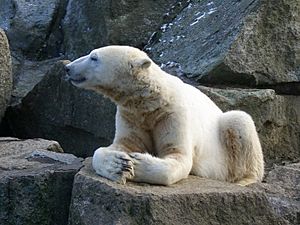Knut (polar bear) facts for kids
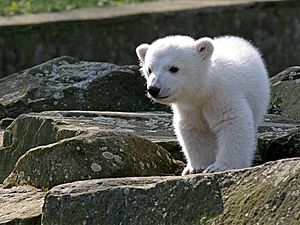
Knut during his debut at the Berlin Zoo in March 2007
|
|
| Species | Polar Bear (Ursus maritimus) |
|---|---|
| Sex | male |
| Born | 5 December 2006 Berlin Zoological Garden |
| Died | 19 March 2011 (aged 4) Berlin Zoological Garden |
Knut (German pronunciation: [ˈknuːt]; born 5 December 2006 – died 19 March 2011) was a famous polar bear who lived at the Berlin Zoo in Germany. He was born in captivity and his mother did not take care of him. Because of this, zookeepers had to raise him by hand.
Knut was the first polar bear cub to survive past being a baby at the Berlin Zoo in over 30 years. He became incredibly popular around the world. People called his fame "Knutmania." This led to many toys, books, and TV shows about him. Knut helped the Berlin Zoo earn a lot of money, about €5 million in 2007. The number of visitors to the zoo went up by 30 percent, making it their best year ever.
Sadly, Knut died unexpectedly on 19 March 2011, when he was only four years old.
Contents
Knut's Early Life
Knut was born at the Berlin Zoo on 5 December 2006. His mother, Tosca, was 20 years old, and his father, Lars, was 13. Tosca had two cubs, but she left them alone. Zookeepers quickly rescued the cubs. Sadly, Knut's brother died a few days later from an infection.
Knut was very tiny, about the size of a guinea pig. For his first 44 days, he stayed in a special incubator. Then, a kind zookeeper named Thomas Dörflein took over raising him.
Dörflein took care of Knut all the time. He even slept next to Knut's crate at night. He played with Knut, bathed him, and fed him every day. Knut started with baby formula and cod liver oil. As he grew, he ate milk porridge mixed with cat food and vitamins. Dörflein also brought Knut out for public shows twice a day. This made Dörflein famous in Germany, and he received an award for his amazing care. Thomas Dörflein passed away on 22 September 2008.
Becoming a Star
On 23 March 2007, Knut was shown to the public for the very first time. About 400 journalists came to the Berlin Zoo to report on "Knut Day." News about Knut spread all over the world.
Because Knut was so famous, many stories about his health appeared. For example, one time he was taken off display because of teething pains. But some reports wrongly said he was very sick. There was even a scary death threat sent to the zoo, but nothing happened.
Even as Knut grew bigger, he still attracted huge crowds. By July 2007, he was seven months old and weighed 50 kg (110 lb). The zoo stopped his twice-daily public appearances because it was becoming unsafe for his keeper. They also wanted Knut to spend more time with other bears. He first lived with a Malaysian black bear cub, then moved to his own space. Knut remained a huge attraction, with 400,000 visitors in August 2007.
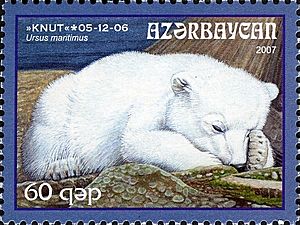
News about Knut continued worldwide. His diet was changed to help him stay healthy and not gain too much weight. They even limited his favorite treats, like croissants. When he hurt his foot slipping on a wet rock, fans from all over sent messages of support.
By November 2007, Knut weighed over 90 kg (198 lb). He was too big for close contact with humans. His first birthday was a big event, broadcast live on German television. The Berlin mint even made 250,000 special silver coins to celebrate. The zoo hoped Knut would grow up to help other zoos by having cubs, which would help protect his species. When another polar bear cub named Flocke was born in similar circumstances, some people hoped she and Knut might become mates one day.
Knut's Later Years (2008–2010)
A year after his first public appearance, Knut weighed more than 130 kg (286 lb). A strong glass wall was put up between him and visitors for safety. One of Knut's keepers said that Knut missed his human father-figure, Thomas Dörflein. He also said Knut had become very used to attention and would cry if no one was near his home.
In July 2008, another zoo, the Neumünster Zoo, which owned Knut's father, wanted some of the money Knut was earning. The Berlin Zoo eventually agreed to pay €430,000 to keep Knut in Berlin.
In September 2009, a female polar bear named Giovanna moved to Berlin. She was about the same age as Knut and briefly shared his home while her own home was being fixed.
Until his death, Knut lived with three female polar bears: Nancy, Katjuscha, and his mother Tosca. Some news reports suggested the older bears were aggressive towards Knut. However, a zookeeper said that Knut was still young and learning how to act like an adult male polar bear. He believed Knut would learn to get respect over time.
Knut's Death
On 19 March 2011, Knut suddenly collapsed and died in his enclosure. He was only four years old. About 600 to 700 zoo visitors saw it happen. Witnesses said his back left leg started shaking, then he had seizures and fell into the pool.
A few days later, a special examination showed "significant changes in the brain" that likely caused his sudden death. Some animal welfare groups blamed the zoo, saying Knut died from stress because he was forced to live with three female polar bears. But the zoo denied this. They said it's normal for polar bears in zoos to live together, and they wanted Knut to learn social skills from the older females. They stated he played with the other bears and seemed relaxed and strong.
Knut's death made people around the world very sad. Many fans visited the zoo, leaving flowers and gifts near his enclosure. The mayor of Berlin, Klaus Wowereit, said, "We all held him so dearly. He was the star of the Berlin zoos."
In 2015, scientists found out that Knut died from a rare brain disease called anti-NMDA receptor encephalitis.
Remembering Knut
The Berlin Zoo planned to build a monument to Knut, paid for by donations from his fans. On 24 October 2012, a bronze sculpture called "Knut – The Dreamer" was revealed at the zoo. It shows Knut "stretching out dreamily on a rock."
Knut's remains were also put on display at Berlin's Museum of Natural History. This caused some debate among fans. A full-sized sculpture covered in Knut's real fur was shown to the public in February 2013. It was part of an exhibition about climate change and protecting the environment. The museum explained that it was an "artistically valuable sculpture with the original fur," not just a stuffed animal.
Knut's exhibit also traveled to the Naturalis Biodiversity Center in the Netherlands in 2013. He returned to Berlin's Museum of Natural History in 2014 for a special exhibition on taxidermy.
Knut's Impact
Commercial Success
The Berlin Zoo officially registered "Knut" as a trademark in March 2007. This made the zoo's shares on the stock market more than double in value. The zoo reported that in 2007, their visitor numbers went up by about 30 percent. This made it the most profitable year in the zoo's 163-year history. Knut earned the Berlin Zoo almost €5 million that year, mostly from more visitors and merchandise sales.
Many companies made money from Knut's fame. They created things like ringtones and cuddly toys. The toy company Steiff made several Knut plush toys. The first 2,400 toys sold out at the Berlin Zoo in just four days. The money from the Steiff toys was used to improve the polar bear enclosure at the zoo.
The candy company Haribo even released a raspberry-flavored gummy bear called Cuddly Knut. They promised to donate ten cents to the zoo for every tub sold. These gummy bears sold so well that Haribo had to open a second factory to keep up with demand.
Knut was also the subject of several popular songs in Germany. A nine-year-old girl named Kitty sang "Knut is Cute" and "Knut, der kleine Eisbär" (meaning "Knut, the little polar bear"). In Britain, comedian Mitch Benn sang songs about Knut on a BBC radio show. A journalist kept a blog with updates about Knut in German, English, and Spanish. There was even a weekly TV show in Germany just about the polar bear cub. Knut also appeared on the cover of Vanity Fair magazine in Germany.
In May 2007, a publishing company and the Berlin Zoo signed a deal for books about Knut. The goal was to raise awareness about global warming. The book, called Knut, der kleine Eisbärenjunge (Little Polar Bear Knut), told Knut's life story with new photos. It was the first book about Knut officially approved by the Berlin Zoo. It was published in Germany and then in the United States, Japan, England, and other countries.
In December 2007, the zoo director confirmed a Hollywood film producer wanted to make an animated movie about Knut. The film, Knut und seine Freunde (Knut and His Friends), came out in Germany in March 2008. It showed how Knut was rescued and also featured other bears.
Helping the Environment
Because Knut was so popular, he became a way to talk about important environmental issues. Dr. Gerald Uhlich from the Berlin Zoo said Knut could "draw attention to the environment in a nice way." Germany's Environment Minister, Sigmar Gabriel, even made Knut the mascot for a conference about endangered species. He said that while Knut was safe, polar bears around the world are in danger. If Knut could help this cause, it was a good thing.
Famous photographer Annie Leibovitz took pictures of Knut for an environmental campaign. One photo showed him with actor Leonardo DiCaprio in Vanity Fair magazine. Knut was also on the logo for the German Environment Minister's campaign to stop global warming. In 2008, a special stamp was released showing Knut with the slogan "Natur weltweit bewahren" ("Preserve nature worldwide").
See also
 In Spanish: Knut (oso polar) para niños
In Spanish: Knut (oso polar) para niños
- Binky (polar bear)
- List of individual bears


